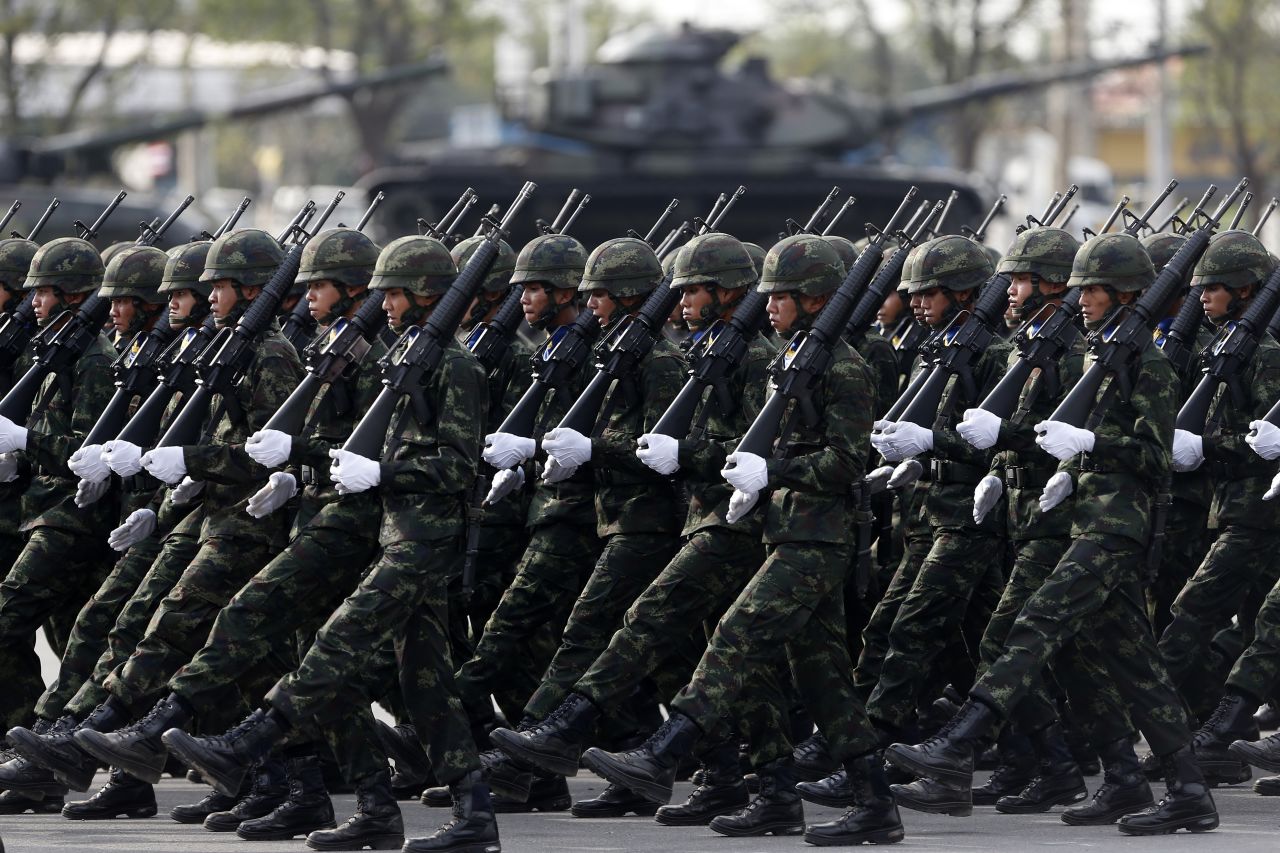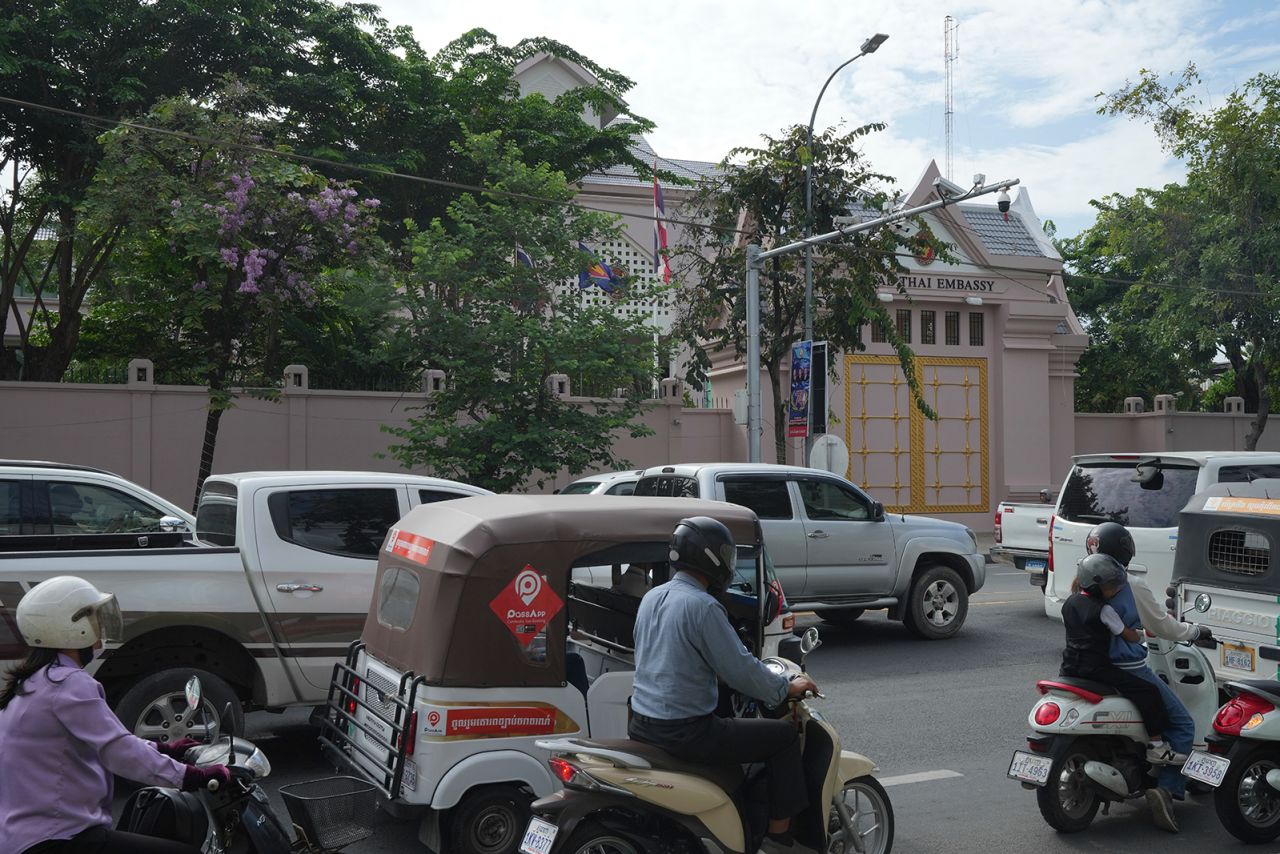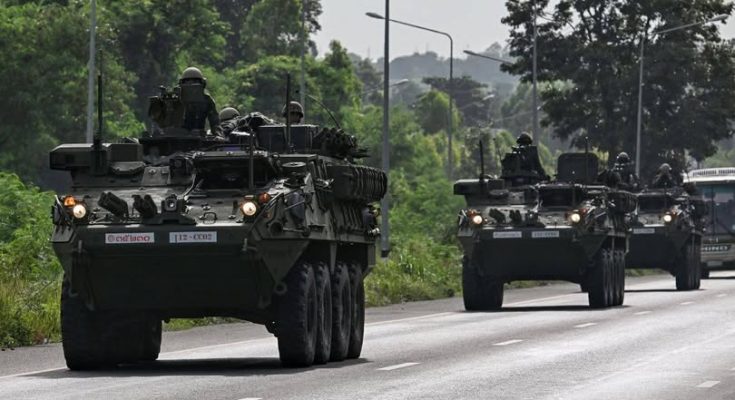What we covered here
• Thailand launched airstrikes against Cambodian military targets along their long-disputed border, escalating tensions between the Southeast Asian neighbors. Thailand also accused Cambodia of launching rockets into civilian areas. Thailand’s health ministry said that at least 12 people, including 11 civilians and one soldier, have been killed in clashes with Cambodian troops.
• The strikes came a day after a Thai soldier lost his leg to a landmine on the border, prompting a downgrade of diplomatic ties by both Bangkok and Phnom Penh as relations collapse to their lowest level in years.
• Thailand’s Prime Minister Paetongtarn Shinawatra was suspended this month and could face dismissal after the leak of a phone call she had with Cambodia’s powerful former leader Hun Sen, in which she appeared to criticize her army’s actions in the dispute.
• Thailand and Cambodia have a relationship of both cooperation and rivalry. They share a 500-mile (800-kilometer) land border — largely mapped by France when it ruled Cambodia — that has periodically seen military clashes and been the source of political tensions.
Our coverage has ended for the day. Get up to speed on the latest updates in the Thailand-Cambodia border clashes here or by reading through the updates below
Cambodia condemns Thai military over damage to UNESCO World Heritage Site
Cambodia’s Ministry of Culture and Fine Arts has expressed its “strongest condemnation of the aggression” carried out by Thailand’s military, saying that the targeting of Preah Vihear temple — a UNESCO World Heritage Site — “may constitute war crimes.”
In a statement Thursday, the ministry called the strikes a “grave and unacceptable violation of international law” and a “blatant disregard” for legal obligations to protect cultural heritage.
The strikes caused “significant damage” to both the “surrounding area and the structures” of the temple, it said. The temple, it added, is a “sacred cultural site and historical legacy of the Cambodian people.”
The ministry claimed Thailand’s “aggressive actions” are both a “cultural disaster and a moral tragedy,” warning of “far-reaching consequences for global heritage and the national identity of the Cambodian people.”
The ministry demanded the stop to military activity near the temple.
Cambodia’s defense ministry said earlier Thursday that a Thai F-16 fighter jet had dropped two bombs on a road near the 11th-century temple as clashes erupted at several flashpoints along the two countries’ disputed border.
Japan urges Cambodia and Thailand to “de-escalate” border tensions
Japan has expressed “deep concern” over the ongoing military clashes between Cambodia and Thailand, urging both sides to show “maximum restraint” and resolve tensions through dialogue.
“Japan has been working to encourage both countries to de-escalate the situation,” Foreign Minister Takeshi Iwaya said in a statement on Thursday. “A sound relationship between Cambodia and Thailand is extremely important for peace and stability in the region.”
He added that he “strongly hopes” that the tension between the two countries “will be eased peacefully through dialogue.”
Thailand has launched airstrikes at Cambodia. Here’s what to know

Royal Thai Army soldiers ride on an armored vehicle in Chachoengsao province, Thailand on Thursday.
If you’re just joining us, Thailand has launched airstrikes against what it says were Cambodian military targets along the two countries’ long-disputed border. It has also accused Cambodia of firing rockets into Thai civilian areas, resulting in at least one death.
For its part, Cambodia has said it would “respond decisively” to the strikes, accusing Thai forces of violating arrangements by ascending to the Ta Muan Thom Temple and deploying barbed wire at the base of the temple. It also said Thai forces launched a drone.
Here’s how this all unfolded:
- Skirmishes in May: Tensions between the two countries started to worsen in May, when a Cambodian soldier was killed during a brief clash between Thai and Cambodian troops in a contested border area of the Emerald Triangle, where Cambodia, Thailand, and Laos meet. Thai and Cambodian forces said they were acting in self-defense and blamed each other for the skirmish. Although military leaders from Thailand and Cambodia said they wished to de-escalate, both sides have since engaged in saber-rattling and reinforced troops along the border.
- Thai PM suspension: The Thai Prime Minister Paetongtarn Shinawatra was suspended from duties earlier this month and could face dismissal after the leak of a phone call she had with Cambodia’s powerful former leader Hun Sen — Cambodian Prime Minister Hun Manet’s father — in which she appeared to criticize her own army’s actions in the dispute.
- Soldier loses leg: On Wednesday, a Thai soldier lost his leg to a landmine on the border, prompting a downgrade of diplomatic ties by both Bangkok and Phnom Penh.
- Thailand deploys jets: After the soldier lost his leg, a Thai fighter jet dropped bombs on Cambodian military targets along their disputed border on Thursday.
- Cambodia responds: Cambodia’s defense ministry confirmed that a Thai F-16 had dropped two bombs on a road near the ancient Preah Vihear temple, a UNESCO World Heritage Site. It condemned what it called “brutal, barbaric, and violent military aggression,” accusing Thailand of violating international law.
- Civilians killed: Armed clashes between the two Southeast Asian neighbors killed at least 11 civilians and one soldier in Thailand. Cambodia has not yet released a civilian death toll.
- Thailand accuses Cambodia of strikes: Thailand has accused Cambodia of launching a strike on civilian infrastructure. Cambodia has not yet responded to this accusation, but earlier swore to “respond decisively.”
- End of talks until fighting stops: The Thai government has called on the international community to condemn Cambodia’s actions in a post on Facebook, accusing the country of being a “war-monger that disregards human rights by continuously using heavy weapons against civilian targets.” The acting prime minister said the country will not resume talks until the fighting stops.
The Cambodian prime minister urges his country’s citizens in Thailand to return if they don’t feel safe
Cambodian Prime Minister Hun Manet speaks during a press conference in Tokyo on May 30.
Cambodian Prime Minister Hun Manet on Thursday urged his country’s citizens living in Thailand to “maintain their morality and dignity” and to return home if they are “facing pressure from discrimination.”
He added: “For Cambodian citizens who are living, working, or studying in Thailand and may be facing pressure from discrimination and wish to return to Cambodia, please come back to our country.”
At least 12 killed in Thailand amid clashes on disputed border, officials say
Thailand’s health ministry said Thursday that 12 people, including 11 civilians and one Thai soldier, have been killed in clashes with Cambodian troops on the disputed border.
A further 31 people, including 24 civilians and seven soldiers, have been injured, the ministry said.
Cambodian authorities have not yet reported any fatalities on their side.
Thailand and Cambodia have disputed their border since it was drawn. Here’s what led to today’s tensions

A Cambodian solider guards the grounds of the Preah Vihear temple in Cambodia in 2011.
Thailand and Cambodia have a long history of periodic military flare-ups and nationalist disputes.
French officials, during their colonial rule in Cambodia, drew a map of the border in 1907 that Thailand contested — saying France did not fully demarcate certain areas, including the sites of several temples.
Here’s a look at the events leading to today’s conflict:
2011: Thai and Cambodian troops clashed in an area surrounding the Preah Vihear temple, displacing thousands of people on both sides and killing at least 20 people.
May 28: Tensions resurfaced when a Cambodian soldier was killed during a brief clash between Thai and Cambodian troops in the contested border area of the Emerald Triangle, where Cambodia, Thailand and Laos meet. Thai and Cambodian forces said they were acting in self-defense and blamed the other for the skirmish.
July 1: Thailand’s Prime Minister Paetongtarn Shinawatra was suspended from duty and now faces possible dismissal after a leaked phone call with Cambodia’s former leader in which she appeared to criticize her own army’s handling of the conflict.
July 16: A landmine explosion in a contested area wounded three Thai soldiers when one of them stepped on it and lost a foot.
July 23: On Wednesday, a landmine blast in a contested area wounded five Thai soldiers, including one who lost a leg. In response, Thailand recalled its ambassador to Cambodia and closed all border crossings with its neighbor.
July 24: Cambodia, in turn, announced that it was downgrading diplomatic relations with Thailand to the lowest level and recalling all embassy staff from Bangkok.
Thailand rules out talks with Cambodia until fighting stops, acting PM says

Thailand’s caretaker Prime Minister Phumtham Wechayachai speaks to media after a cabinet meeting in Bangkok, Thailand on July 3.
No negotiation with Cambodia can take place until fighting along the border ends, Thailand’s caretaker Prime Minister Phumtham Wechayachai said.
The acting premier said there had been no declaration of war and that conflict was not spreading into more provinces, according to Reuters.
He added that Cambodia had fired heavy weapons into Thailand without clear targets, leading to civilian deaths.
Cambodia previously said a Thai F-16 fighter jet dropped two bombs on a road. There was no immediate information on casualties on the Cambodian side.
Thailand calls for international condemnation of Cambodia
Thailand’s government called for “international condemnation” of Cambodia in a statement posted on its official Facebook page.
Government spokesperson Jirayu Houngsub accused Cambodia of “being a war-monger that disregards human rights by continuously using heavy weapons against civilian targets.”
The post claimed Cambodian forces fired heavy weapons into civilian areas — including a hospital and homes in Surin province — resulting in several casualties.
What caused the flare-up between Thailand and Cambodia?

An injured Thai soldier who stepped on a land mine is airlifted to a hospital in Ubon Ratchathani province, Thailand, on Wednesday.
Tensions worsened in May when a Cambodian soldier was killed during a brief clash between Thai and Cambodian troops in a contested border area of the Emerald Triangle, where Cambodia, Thailand, and Laos meet.
Thai and Cambodian forces said they were acting in self-defense and blamed the other for the skirmish.
Although military leaders from Thailand and Cambodia said they wished to de-escalate, both sides have since engaged in saber-rattling and reinforced troops along the border.
Thailand took control of border checkpoints, imposed restrictions on crossings and threatened to cut electricity and internet to Cambodia’s border towns. Cambodia, in return, stopped imports of Thai fruit and vegetables and banned Thai movies and TV dramas.
Recent landmine explosions prompted both countries to downgrade relations with each other and recall diplomatic staff.
The first soldier lost his leg in a landmine explosion on July 16. The second incident occurred Wednesday, when a blast injured five Thai soldiers, with one losing his leg. Thursday’s violence marked a significant escalation.
The conflict has had huge political ramifications in Thailand.
Thailand’s Prime Minister Paetongtarn Shinawatra was suspended from duties on July 1 after the leak of a phone call she had with Cambodia’s powerful former leader Hun Sen in June, in which she appeared to criticize her own army’s actions in the dispute.
Shinawatra hails from a powerful dynasty and became Thailand’s youngest prime minister last year, at just 38. She could face full dismissal over the call, in which she appeared to signal there was discord between her government and the powerful Thai military.
Few international tourists visit the area where Thai and Cambodian forces clashed
The area where Thai and Cambodian forces clashed today, near the ancient Ta Muen Thom Temple, is not considered a popular destination for international travelers.
The temple lies in disputed territory in the south of Thailand’s Surin province and in Cambodia’s northwest. It’s about 250 miles (400 kilometers) northeast of the Thai capital Bangkok and a five-to-six-hour drive by car.
Surin’s airport does not currently serve commercial flights. The nearest airport offering daily connections with Bangkok is in neighboring Buriram province, about an hour’s drive from downtown Surin and 90 minutes from the temple.
The Tourism Authority of Thailand has increased efforts to promote the country’s northeast in recent years, highlighting its unique cuisine, festivals and ancient sites. The region comprises 20 provinces, including Buriram and Surin, and is collectively referred to as Isan.
Unlike Thailand’s north, home to popular destinations such as Chiang Mai, Pai and Chiang Rai, Isan has remained off the radar for the bulk of the millions of international tourists who visit the country each year.
At least eight people in Thailand killed by Cambodian attack, Thai police say
At least eight people in Thailand have been killed in clashes with Cambodia today, Thai police said.
A rocket hit a convenience store in Ban Nam Yen, about 12 miles (20 kilometers) from the border with Cambodia, District Chief of Kantharalak District, Sisaket Province, told Thai public broadcaster PBS.
Thailand accused Cambodian troops of firing two BM-21 rockets into a civilian area in Kap Choeng district, in Surin province, wounding three civilians.
Thailand’s Foreign Ministry said Cambodian attacks on civilian areas continued throughout Thursday, including at the Phanom Dong Rak Hospital.
“These acts have resulted in further loss of life and injuries among the Thai people,” a ministry spokesperson said in a press conference.
Cambodia previously said a Thai F-16 fighter jet dropped two bombs on a road. There was no immediate information on casualties on the Cambodian side.
Fighting erupted at six locations along entire length of border, says Thai military

A Cambodian BM-21 multiple rocket launcher returns from the Cambodia-Thai border as Cambodian and Thai troops exchanged fire in a new round of clashes in Preah Vihear province on Thursday.
Clashes have been reported along the entire length of the disputed frontier between Cambodia and Thailand, military officials said.
Thai military officials said clashes, involving small arms and heavy weapons, have since spread along the frontline affecting a total of six locations. This includes sites in Surin province, Sisaket and Ubon Ratchathani.
The violence began Thursday morning local time at the ancient, disputed Ta Muen Thom temple site in Thailand’s Surin province, but it is also claimed by Cambodia. Both countries accused their neighbor of firing the first salvo.
Though Cambodia hasn’t acknowledged all six locations, its Defense Ministry said all affected areas “are within Cambodian territory … and are actively protected by Cambodian forces.”
Thailand’s military is more than triple the size of Cambodia’s, and better equipped

Members of the Thai army take part in a ceremony in Saraburi province, Thailand on January 18, 2023.
Thailand’s military dwarfs that of neighboring Cambodia, both in personnel and weaponry.
Thailand’s 361,000 active-duty personnel spread across all branches of its military is three times Cambodia’s manpower.
And Thailand is far ahead of Cambodia when it comes to weaponry.
“Thailand has a large, well-funded military and its air force is one of the best equipped and trained in Southeast Asia,” the International Institute for Strategic Studies wrote in its “Military Balance 2025” report on the world’s armed forces.
The US classes Thailand as a major non-NATO ally, the IISS notes. That has enabled it to enjoy decades of US support for its weapons programs, although it has also boosted ties with China in recent years and has developed a strong domestic weapons industry with the help of countries such as Israel, Italy, Russia, South Korea and Sweden, the report said.
The air force’s equipment includes at least 11 modern Swedish Gripen fighter jets and dozens of older US-made F-16 and F-5 jets, according to the IISS. Cambodia has no combat-capable air force.
On the ground, Thailand has dozens of battle tanks, including 60 modern, Chinese-made VT-4 tanks, and hundreds of older, US-made tanks. Cambodia has around 200 old Chinese- and Soviet-made tanks, the “Military Balance” shows.
The Thai army boasts more than 600 artillery pieces, including at least 56 powerful 155mm weapons and more than 550 105mm towed guns. Cambodia has only a dozen 155mm guns with around 400 smaller towed artillery pieces, according to IISS figures.
In the air, the Thai army has US-made Cobra attack helicopters and 18 US Black Hawk transports. Cambodia has only a few dozen older Soviet and Chinese transport helicopters.
Thailand’s armed forces are also regular participants in international military exercises, most prominently the annual Cobra Gold exercises, which Bangkok co-hosts with the US Indo-Pacific Command. Cobra Gold began in 1982 as joint drills with the US, but has added dozens of other participants since then. It’s the longest-running international military exercise in the world, according to the US military.
Thai embassy urges citizens to leave Cambodia, warning conflict “is likely to be prolonged and may expand”

Local vehicles pass the Thai Embassy in Phnom Penh, Cambodia, on Thursday.
The Thai embassy in the Cambodian capital Phnom Penh is urging its citizens to leave the country “as soon as possible” as border clashes intensify, warning that the conflict “is likely to be prolonged and may expand further.”
“Thai citizens currently residing in Cambodia without an essential reason to remain are advised to leave the country as soon as they can do so safely,” the embassy said on Facebook.
The embassy also advised against any non-essential travel to Cambodia.
Cambodia confirms Thai airstrikes hit its territory, accuses neighbor of “brutal” aggression
Cambodia’s Defense Ministry has confirmed that Thailand’s airstrikes hit its territory, and said it would “respond decisively.”
“F-16 fighter jet dropped (two) bombs on the road leading to Wat Kaew Seekha Kiri Svarak Pagoda,” it said in a statement, referring to an area on Cambodia and Thailand’s disputed border. “All of these areas are within Cambodian territory.”
Thailand said it had readied six F-16 jets, and later claimed to have “destroyed” two Cambodian regional military headquarters.
Cambodia denounced what it described as Thailand’s “brutal, barbaric and violent military aggression,” its statement said.
Cambodia said Thailand’s actions violate international law and “pose an extreme danger not only to regional peace and stability but also to the foundations of the international rules-based order.”
Before jets were launched, armed clashes between Thai and Cambodian forces broke out
Hours before Thailand deployed F-16 fighter jets against Cambodian military targets, armed clashes between Thai and Cambodian forces broke out along the border on Thursday, according to military officials.
They began early morning when Thailand’s military said Cambodian troops fired at a Thai army base in an area near the ancient Ta Muen Thom Temple – which lies in disputed territory in the south of Thailand’s Surin province and in Cambodia’s northwest. It said Cambodia had deployed an unmanned drone in front of the temple before sending troops in with weapons.
It also accused Cambodian troops of firing heavy weapons into a civilian area in the nearby Kap Choeng district, in Surin province.
“The attack injured three civilians. Thai authorities have promptly evacuated residents from the area to ensure the safety of lives and property,” the military said in a statement.
A Cambodian Defense Ministry spokesperson said their troops had acted in self-defense after an unprovoked incursion from Thai soldiers.
“Cambodian forces acted strictly within the bounds of self-defence, responding to an unprovoked incursion by Thai troops that violated our territorial integrity,” Lieutenant General Maly Socheata said.
Cambodia’s Prime Minister Hun Manet said in a post on Facebook that Thailand attacked army positions at two temple sites in its Oddar Meanchey province, as well as in Cambodia’s Preah Vihear province and Thailand’s Ubon Ratchathani province.
“Cambodia has always maintained a position of peaceful resolution of problems, but in this case, we have no choice but to respond with armed force against armed aggression,” said the Prime Minister.
Hun Manet also called on Cambodian citizens to remain calm.
At least two Thai soldiers were injured on Thursday, Reuters reported, citing a Thai army official.
Two hospitals in Thailand’s Surin province near the site of the clash have begun evacuating patients, according to Thailand’s ministry of public health.





